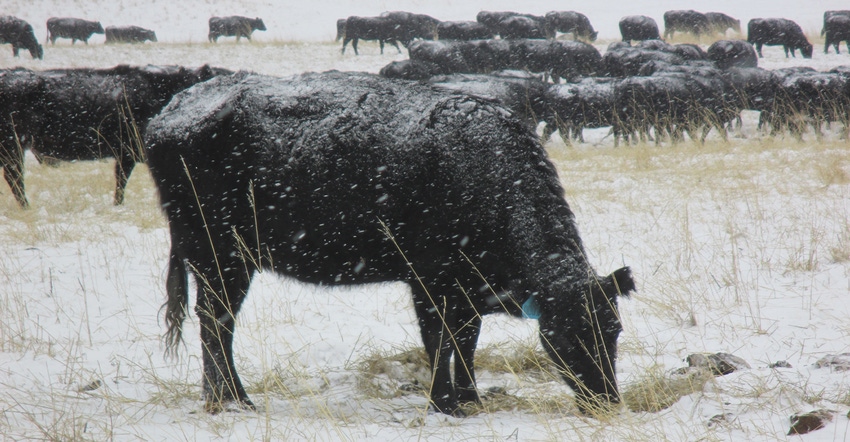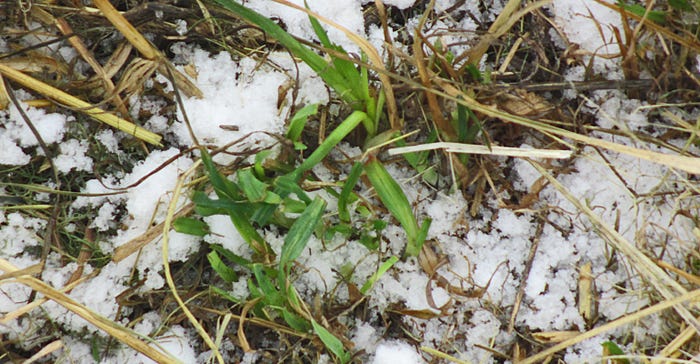July 26, 2019

Planning makes grazing cattle year-round in the Rocky Mountain West possible. It does require high-yielding, cold-tolerant forage varieties and rotational grazing.
These adjustments to grass species and stock management may seem onerous at the outset. But they make dollar sense when compared to producing, baling and feeding hay, which is the largest expense of a cow-calf operation.
To discover suitable winter pasture forages, the USDA Agriculture Research Service is six years into a 44-acre, 11-treatment forage study on the Sieben Livestock Co. outside Adel, Mont.
Sieben Livestock sits at nearly 5,000 feet in elevation, and there is a year-round frost risk. It in the 13-to-15-inch precipitation zone. Its dryland pasture previously produced orchard grass and alfalfa. These forages would often freeze, reducing feed quality and yield. Because there wasn’t enough forage stockpiled for winter grazing, the ranch was forced to feed hay.
“With newer grass varieties and different mixes, we shifted the ranch from grazing 1,000 mama cows on 100 acres for 24 hours, to 20 acres in 24 hours,” says Kevin Jensen, ARS research plant geneticist with the Utah State University Forage and Range Research Lab.

DIGGING IN: Intermediate wheatgrass and meadow bromegrass maintain their protein and energy source through snow cover Seiben Livestock Co. cattle are able to graze year-round near Adel, Mont.

Forage species
The highest-yielding test plot at Sieben Livestock is the intermediate wheatgrass and meadow brome. Other plots grow the following species as monocultures: meadow brome, tall fescue, orchardgrass, crested wheatgrass and intermediate wheatgrass. Forage mixes include meadow brome and intermediate wheatgrass, with each of the following legumes: alfalfa, sainfoin and small burnet. Then, test plantings of meadow brome and tall fescue contain alfalfa or sainfoin. Finally, there is also a control site of orchardgrass with alfalfa.
“These stands were planted in 2013,” Jensen explains, “This is the first year we feel confident to make recommendations. We know what environmental parameters make which grass species work under rotational grazing — and plant species that persist. Sainfoin and birdsfoot trefoil went out, but the alfalfa is still there. And our yields remain really good.”
Central Montana receives most of its precipitation in April, May and June. In the Great Basin, rain ceases in May. Because of this, forage species that work for Sieben Livestock may not work for a grazier in Utah.
“We’re now looking at what species work for the Great Basin,” Jensen says. “In the 8-to-11-inch precipitation zone, there’s not much summer precip. You need to use your drier species: crested, Siberian and Russian. Add dryland alfalfa, like Great Ladak or Ranger. Then usually some forage kochia.”
Rotate the stockpile
Sieben Livestock stockpiles pasture forage and grazes its pasture on a 24-hour annual rotation. Each 20-acre section contains 1,000 pairs for one day. Then, that grass rests for an entire year before it’s grazed again.
The ranch’s goal is to graze 365 days a year. The ranch’s cattle calve in May and June up on its summer mountain lease. Then, they rotate through the improved pastures in the valley during the remainder of the year. The ranch does bale some emergency hay for heavy snowstorms.
“Mostly, the snow cover doesn’t hinder grazing,” Jensen says. “But it can have an impact if the snow crusts up, because the cattle can’t nuzzle down to the grass. If it gets really cold, the [ranch] might throw a bit of feed out, or nutrient blocks.
"If you become a grass farmer,” Jensen advises, “your cattle will make you money. If you can utilize that animal as the harvester, you will save a lot of money.”
Don’t stress it
The Seiben cattle are handled daily to rotate through the ranch’s heavy grazing routine. To prevent weight loss and stress during these frequent moves, the ranch uses stock handling methods promoted by Bud Williams and Whit Hibbard. The following steps are sourced from Hibbard and based on Williams’ teachings:
Keep animals in a normal frame of mind. An animal’s survival instincts are activated when it becomes anxious, fearful or defensive. This causes an animal to react instead of respond to a handler.
Animals should not be forced to do anything that they don’t want to do, or they are not ready to do. Low-stress stock handling prepares an animal for what the handler wants them to do through communication and application of proper pressure.
Set up every situation so our idea becomes the animals’ idea. Communicating and preparing animals to move into the squeeze chute will shift them mentally to what the handler wants them to do, instead of moving them physically.
Animals want to avoid pressure, and they need to experience release from pressure. Cattle will move away from uncomfortable pressure. They need to feel the reward of the pressure release, though, to continue the desired behavior of moving away from applied pressure.
They want to be in a herd. Cattle naturally congregate in herds for safety from predators. Unfortunately, through improper handling, many learn that being in a herd is unpleasant. This is because of the tight formations they are often pushed into by handlers. Adequate space in corrals, alleyways and loose groupings on a drive will maintain cattle’s desire to be in a herd.
They want to move in the direction they are headed. Cattle tend to move in the direction they are already headed, perhaps because it’s easier than turning. It is helpful to understand this to determine the handler’s angle of approach.
They want to follow other animals. Cattle are social animals and prefer to follow other cattle. To create movement in a herd, only one animal needs to head to another place. The others will follow it.
Animals want to see what’s pressuring them. They want to see where you want them to go. A handler should position herself in a way that makes her visible to the cattle.
They want to go by you or around you. This is why moving from front to back in an alleyway increases the animals’ pace. And why, in a crowd pen — whether wedge-shaped, a tub or a Bud Box — animals respond best to the handler working the inside arc.
Under excess pressure, they want to go back where they came from. If cattle are scared, they try their best to return to the last place they were comfortable.
Hemken writes from Lander, Wyo.
About the Author(s)
You May Also Like




